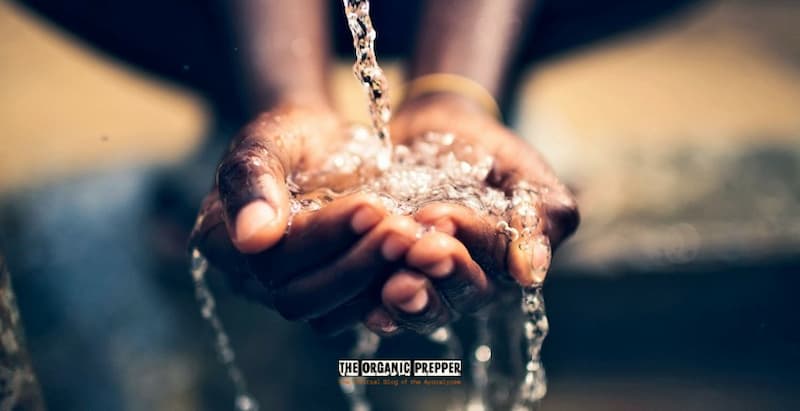() Water is the most important prep, in my book. Even living in a tropical country with an abundance of water, easy access to clean water can sometimes get scarce. It’s impossible to write about water without mentioning the minimum ration: one gallon per day per person. But, what do you do to get water when there is no power?
Related Food and Water: What You Eat Matters for People & the Planet
As usual, your surroundings and what you have around you will determine what method you use to provide yourself with water. Sure, advanced preppers inform that in extreme conditions, some water sources could be unusual ones, such as toilet tanks, water heaters, irrigation systems, the grid pipelines itself in their lower spots, and others.
Even fire hydrants could be a water source, but (and it’s a BIG but) these systems are under a VERY dangerous level of pressure, and I would advise against it unless you know very well what you’re doing. Furthermore, the chances are that this water is chemically treated with products to avoid corrosion, for example, and unsafe for our purposes. So, buyer beware.
Getting water when there is no power after a city-wide collapse is difficult.
My point is that cities are dangerous places to live after a collapse. Consider the rise in crime, for example.
Urbanites are definitely at a disadvantage here when we talk about having access to safe water continuously. Let’s say the grid stops working. If your big city job is gone (like what happened to me), then staying in the city then is probably not your best move. We can identify basically three water sources that should be safe once SHTF and we need water.
These main sources are:
- Rainwater collection
- Rivers/streams/seawater desalination.
- Wells
Each one of these has its own advantages and disadvantages.
Rainwater
You have to have rain to collect it, and that’s something that needs to be remembered. A few months of a severe drought, and you’re toast if your reservoirs get depleted.
In some areas, rainwater may not be as pure as hoped for, and rainwater should be subject to purification before drinking. I know that fumes from the oil production facilities have made rain here carry a suspiciously high level of heavy metals.
However, worst-case scenario, you just need a roof and a barrel to collect it if you have nothing else. The setups to collect rainwater are as finite as the household itself. Even in a small apartment, it could be possible to collect some water with a couple of tarps, some PVC pipes, good-sized funnels, and jerrycans, given the need.
Surface water sources
Just like with rain, sometimes these sources could carry nasty bugs, and exhaustive purification is a must. However, this can be achievable with good planning and investing. Compared to rainwater, surface water should be available the whole year. If your planning is adequate, the impact on your reservoir should be minimum, which is great. Furthermore, a reservoir for irrigation, for instance, could be as well used as a fish growing tank, producing protein-rich food.
If a drought is present, pumping water out of a permanent stream to our ponds or tanks can make a huge difference. Seawater desalination is expensive with current methods like reversal osmosis. However, using solar distillation could be practical if you have enough space.
(This is a good time to mention that you should read our free QUICKSTART Guide on surviving a summer power outage.)
Wells
Main disadvantage? They’re expensive unless you have some basic knowledge of what you’re doing. This article can look a little bit complicated, but someone with some experience surely could overcome the obstacles and understand the language.
If you don’t plan to bug out and have enough space to build a suburban compound large enough to raise most of your own food, investing in a well is the best use for the money. The cost of drilling one is an incredible amount of money, but if you can afford it, go for it.
Pumping out of them is a different issue, though; using methods like windmills is very likely the best approach.
Water treatment without grid power
We have roughly three options to purify collected off-grid water. Please be aware you should do your own research beforehand.
Pool cleaning products.
Sure, these options will work, but only as long as you have a product available to treat your water. Have a plan to replace your chemicals with an equally safe purifying method.
They say these chemicals have a long shelf life. However, I’ve never used them, and after an accident where my best friend was almost suffocated by a cloud of chlorine gas when we were teenagers, I would say, be careful.
Filtering
No matter the source your water comes from, it is a good practice to filter it. This can be done very inexpensively as well. There are plenty of ways to do this. Check out this link for a wealth of good information.
Distillation
This is one of the safest ways to purify water because many dissolved substances will remain behind once water evaporates. However, the taste is quite different from other clean waters, as, in the process, some salts and other minerals are lost.
Solar
If your area allows for it, this is another quite affordable method for distillation. They are the simplest DIY devices you could build. Their main disadvantage is you would need a very large surface area as its efficiency may be low. The good thing is, they are quite easy to build with some scrap glass sheets and a bit of ingenuity.
Boiling
Provided you have a constant firewood supply or another heat source for your boiler. This is a great method. You experience the same problems with the taste, though, as you do with distillation, and not everyone likes it.
Dehumidifiers
These should have to be massive and would consume too much power to produce the needed water to be practical in many places. However, if you have access to some affordable dehumidifiers, these can be easily rigged to produce water if the humidity in your area is high enough. Water supply may be not be too much, but rest assured, as long as the device is working, it will be there.
My very own personal advice: get an elevated tank. The largest capacity you can afford. No matter how you refill it, size DOES matter regarding water reserves. I know it’s an OPSEC killer, but it’s always concealable to some degree. For when you need pumping water in, this pump is one of the easier to build I’ve ever seen. You won’t need anything exotic. Of course, a wind-powered pump is ideal for filling an elevated tank, maybe even from a deep well, as it has been for many decades. This simple design is one of the most simple I could find, and I truly plan to give it a shot. On the other side, this design using a bicycle is another of the simplest I have ever seen. That chain could use a good tensioner, though.
Upon installing a large tank, make sure ALL of your taps and connections DO NOT LEAK. This may sound like fool advice, but this needs constant inspection and corrective maintenance work. Stashing the needed materials in bulk (much cheaper) and learning how to make those small repairs really end by paying off at the end of the day. You will just need patience, a good lamp, and some music.
Water is vital to life.
You cannot live without it, so the astute prepper will learn all that he can to find it after a disaster. Hopefully, you’ve found the above tips of mine to be of use. What are your thoughts, though? Any comments? Are there other options you would advocate for? Let us know in the comments below.
Thanks for reading, and stay tuned!
About The Author
Jose is an upper middle class professional. He is a former worker of the oil state company with a Bachelor’s degree from one of the best national Universities. He has an old but in good shape SUV, a good 150 square meters house in a nice neighborhood, in a small but (formerly) prosperous city with two middle size malls. Jose is a prepper and shares his eyewitness accounts and survival stories from the collapse of his beloved Venezuela. Jose and his younger kid are currently back in Venezuela, after the intention of setting up a new life in another country didn’t go well. The SARSCOV2 re-shaped the labor market and South American economy so he decided to give it a try to homestead in the mountains, and make a living as best as possible. But this time in his own land, and surrounded by family, friends and acquaintances, with all the gear and equipment collected, as the initial plan was.
Stillness in the Storm Editor: Why did we post this?
The news is important to all people because it is where we come to know new things about the world, which leads to the development of more life goals that lead to life wisdom. The news also serves as a social connection tool, as we tend to relate to those who know about and believe the things we do. With the power of an open truth-seeking mind in hand, the individual can grow wise and the collective can prosper.
– Justin
Not sure how to make sense of this? Want to learn how to discern like a pro? Read this essential guide to discernment, analysis of claims, and understanding the truth in a world of deception: 4 Key Steps of Discernment – Advanced Truth-Seeking Tools.
Stillness in the Storm Editor’s note: Did you find a spelling error or grammatical mistake? Send an email to [email protected], with the error and suggested correction, along with the headline and url. Do you think this article needs an update? Or do you just have some feedback? Send us an email at [email protected]. Thank you for reading.
Source:
https://www.theorganicprepper.com/how-to-get-water/
Support our work! (Avoid Big Tech PayPal and Patreon)DIRECT DONATION


Leave a Reply